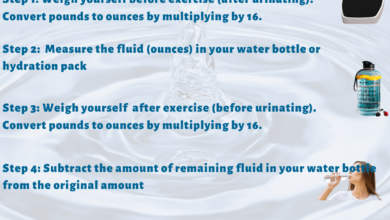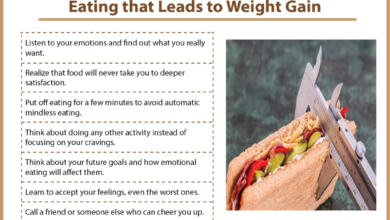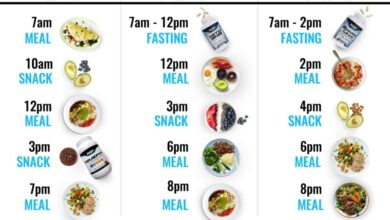
7 Scenarios When Not Working Out Is Healthier
7 Scenarios When Not Working Out Is the Healthier Choice: We all know exercise is vital for our well-being, but sometimes, pushing yourself to workout can actually do more harm than good. There are times when resting, recovering, and prioritizing your mental and physical health over exercise is the smarter choice.
This article explores seven specific situations where taking a break from your workout routine might be the healthiest decision you can make.
From dealing with injuries and illnesses to navigating the demands of pregnancy, postpartum recovery, and intense stress, there are many instances where rest and self-care are paramount. Understanding when to prioritize rest and how to listen to your body’s signals can be crucial for your overall health and well-being.
When Injury or Pain Prevents Exercise

It’s a common misconception that pushing through pain is always the best way to achieve fitness goals. However, there are times when rest and recovery are the healthiest choices, especially when dealing with injuries or persistent pain. Ignoring these signals can lead to further complications and setbacks, making it crucial to understand when to prioritize rest over exercise.
Understanding Different Types of Injuries
Injuries can significantly hinder exercise, ranging from minor sprains and strains to more serious conditions like fractures and tendonitis. Understanding the different types of injuries and their associated limitations is crucial for making informed decisions about exercise.
Sometimes, rest is the best workout. Whether you’re battling a cold, recovering from an injury, or just feeling burned out, listening to your body is key. And when you’re looking for a comforting and nourishing meal that won’t weigh you down, 10 easy chunky chili recipes under 360 calories are a perfect choice.
These healthy and delicious recipes will fuel your body and mind, giving you the energy to tackle your next workout, or simply enjoy a well-deserved day of rest.
Common Injuries and Their Impact on Exercise
- Sprains and Strains:These involve damage to ligaments (sprain) or tendons (strain). Sprains often occur in the ankles, wrists, and knees, while strains commonly affect the back, hamstrings, and shoulders. Exercise limitations vary depending on the severity of the injury, but generally involve avoiding activities that put stress on the affected area.
- Fractures:A fracture is a break in a bone. Depending on the location and severity, fractures can significantly restrict movement and require immobilization, making exercise impossible until the bone heals.
- Tendonitis:This condition involves inflammation of a tendon, often caused by overuse or repetitive motions. Tendonitis commonly affects the shoulder, elbow, wrist, hip, and knee. Exercise limitations typically involve avoiding activities that aggravate the affected tendon.
Seeking Medical Guidance
When dealing with injuries or pain, seeking medical guidance from a qualified healthcare professional is essential. A doctor or physical therapist can diagnose the injury, determine the extent of the damage, and recommend appropriate treatment options, including rest, immobilization, medication, or physical therapy.
During Active Illness
When you’re battling an illness, your body is already working overtime to fight off the infection. Pushing yourself to exercise during this time can actually hinder your recovery and potentially worsen your symptoms. Your body’s energy reserves are depleted during illness, and your immune system is focused on fighting the infection.
Exercise demands additional energy and can divert resources away from your immune response. This can make you feel more exhausted and may even prolong the duration of your illness. Furthermore, exercise can elevate your body temperature and heart rate, which can exacerbate symptoms like fever, chills, and muscle aches.
Rest and Recovery Strategies for Different Illnesses
Rest is crucial for recovery during illness. The type and amount of rest needed will vary depending on the severity and type of illness. Here’s a table outlining appropriate rest and recovery strategies for common illnesses:
| Illness | Rest and Recovery Strategies |
|---|---|
| Common Cold |
|
| Flu |
|
| Gastrointestinal Illness |
|
| Respiratory Infections |
|
During Pregnancy and Postpartum: 7 Scenarios When Not Working Out Is The Healthier Choice
Pregnancy and postpartum are unique phases in a woman’s life, marked by significant physiological changes. While exercise is generally encouraged for overall health, it’s crucial to consider the specific needs and limitations during these periods. In some cases, choosing not to exercise might be the healthier choice, especially when facing certain challenges or risks.
Considerations for Exercise During Pregnancy
It’s essential to prioritize the safety of both the mother and the developing baby during pregnancy. Exercise should be tailored to individual needs and progress gradually.
- Consult with a healthcare provider: Before starting any exercise program, it’s crucial to consult with a healthcare provider, especially if there are any pre-existing health conditions. They can provide personalized guidance based on the individual’s health and pregnancy status.
- Avoid high-impact activities: Activities that involve jumping, jarring movements, or excessive strain on the abdomen should be avoided. These activities can increase the risk of injury or complications.
- Stay hydrated: Drinking plenty of fluids is essential to prevent dehydration, which can be particularly important during pregnancy.
- Listen to your body: It’s crucial to listen to your body and stop if you experience any discomfort, pain, or shortness of breath.
Guidelines for Safe and Effective Exercise Practices During Pregnancy, 7 scenarios when not working out is the healthier choice
Here are some general guidelines for safe and effective exercise practices during pregnancy:
- Moderate-intensity exercise: Aim for at least 150 minutes of moderate-intensity exercise per week, such as brisk walking, swimming, or cycling.
- Avoid overheating: Exercise in a cool environment and wear loose-fitting clothing to prevent overheating.
- Avoid exercising on your back after the first trimester: Lying on your back can compress the vena cava, which can reduce blood flow to the baby.
- Avoid exercises that put pressure on the abdomen: Avoid exercises that involve lying on your stomach or that put excessive pressure on the abdomen.
Safe and Effective Exercises for Different Trimesters and Postpartum Stages
The following table Artikels safe and effective exercises for different trimesters and postpartum stages:
| Trimester/Postpartum Stage | Safe and Effective Exercises |
|---|---|
| First Trimester | Brisk walking, swimming, yoga, Pilates, low-impact aerobics |
| Second Trimester | Continue first-trimester exercises, adding in strength training exercises (with modifications), such as squats, lunges, and bicep curls |
| Third Trimester | Focus on low-impact activities, such as walking, swimming, and prenatal yoga. Avoid exercises that put pressure on the abdomen or require balance. |
| Postpartum (6-8 weeks after delivery) | Start with light exercises, such as walking, and gradually increase intensity as your body recovers. Consult with a healthcare provider before starting any new exercise program. |
When Exhaustion or Mental Health Takes Priority
We often hear about the benefits of exercise for physical health, but it’s crucial to remember that our mental well-being plays a significant role in our overall health. While exercise can be beneficial for mental health, it’s not always the best choice, especially when you’re dealing with exhaustion or mental health challenges.
The Connection Between Mental Health and Physical Activity
There is a strong connection between mental health and physical activity. Exercise can be a powerful tool for managing stress, anxiety, and depression. It releases endorphins, which have mood-boosting effects, and it can help improve sleep quality and reduce feelings of isolation.
However, it’s important to acknowledge that the relationship between exercise and mental health is complex. For some individuals, especially those experiencing significant mental health challenges, pushing themselves to exercise can be counterproductive and exacerbate existing issues.
The Impact of Burnout and Stress on Exercise Performance
Burnout and stress can negatively impact exercise performance and overall well-being. When you’re feeling overwhelmed and exhausted, your body may be signaling that it needs rest and recovery, not additional exertion. Pushing yourself to exercise when you’re burned out can lead to:
- Decreased motivation and energy levels.
- Increased risk of injury.
- Exacerbation of mental health symptoms.
- Reduced sleep quality.
Strategies for Prioritizing Mental Well-being and Managing Exhaustion
When exhaustion or mental health concerns take priority, it’s essential to prioritize your well-being and listen to your body’s signals. Here are some strategies for managing exhaustion and prioritizing your mental health:
- Prioritize sleep: Aim for 7-9 hours of quality sleep each night. Sleep deprivation can exacerbate stress and exhaustion, making it harder to cope with mental health challenges.
- Practice mindfulness and relaxation techniques: Mindfulness meditation, deep breathing exercises, and yoga can help calm your mind and reduce stress.
- Engage in activities that bring you joy: Spending time on hobbies, connecting with loved ones, and pursuing activities that bring you joy can help boost your mood and reduce stress.
- Seek professional help: If you’re struggling with significant mental health challenges, it’s important to seek professional help from a therapist or counselor.
During Periods of Intense Stress or Emotional Distress

It’s common to feel the urge to work out when you’re stressed, as exercise can be a great way to manage stress in the long run. However, during periods of intense stress or emotional distress, pushing yourself to exercise might actually do more harm than good.
When you’re under a lot of stress, your body is in “fight or flight” mode. This means your body is releasing hormones like cortisol and adrenaline, which can make you feel anxious, irritable, and on edge. These hormones also suppress your immune system, making you more susceptible to illness.
The Impact of Stress on the Body and Its Relationship to Exercise
Stress has a significant impact on your body, both physically and mentally. It can lead to various health problems, including:* Increased heart rate and blood pressure:Stress triggers the release of hormones that increase your heart rate and blood pressure, putting extra strain on your cardiovascular system.
Muscle tension and pain Stress can cause muscle tension and pain, especially in the shoulders, neck, and back.
Sleep disturbances Stress can make it difficult to fall asleep and stay asleep, leading to fatigue and irritability.
Weakened immune system Stress suppresses the immune system, making you more susceptible to infections and illnesses.
Sometimes, the best way to take care of yourself is to listen to your body and give it a break from intense exercise. Whether you’re recovering from an injury, feeling run down, or simply need a mental reset, taking a day or two off can be incredibly beneficial.
If you’re looking for a way to manage your calories and optimize your fasting windows, I’ve found that intermittent fasting with MyFitnessPal premium is a great tool for staying on track. And remember, those rest days are just as important as the workout days, allowing your body to rebuild and recover, so you can come back stronger than ever.
Digestive problems Stress can cause digestive problems like heartburn, constipation, and diarrhea.When you exercise while under intense stress, you are essentially adding another stressor to your body. This can lead to a vicious cycle of stress, fatigue, and burnout. You may find that your workouts are less effective, as your body is already taxed and unable to recover properly.
Benefits of Rest and Relaxation Versus Exercise in Managing Stress
Instead of pushing yourself to exercise, focus on rest and relaxation during periods of intense stress. Here’s why:* Rest allows your body to recover:When you’re under stress, your body needs time to recover and repair. Resting allows your body to regulate its hormones, reduce muscle tension, and improve sleep quality.
Relaxation techniques can reduce stress hormones Activities like meditation, deep breathing, and yoga can help reduce the levels of stress hormones in your body.
Sometimes, taking a break from exercise is the best thing for your body. There are definitely times when resting is the healthier choice, like when you’re feeling sick or recovering from an injury. And let’s not forget about the impact of your environment on your health.
Did you know that exercising in polluted areas could be bad for your health ? It’s important to be aware of your surroundings and prioritize your well-being, even if that means taking a day off from your usual workout routine.
Remember, sometimes the best way to get back to your fitness goals is to take a step back and listen to your body.
Rest can improve your mood Rest and relaxation can help improve your mood, reduce anxiety, and promote feelings of calm and well-being.
Alternative Stress-Reducing Activities
There are many effective ways to manage stress without exercise. Consider these alternatives:* Mindfulness meditation:Mindfulness meditation involves focusing on the present moment and accepting your thoughts and feelings without judgment. It can help reduce stress, improve focus, and promote relaxation.
Deep breathing exercises Deep breathing exercises can help slow your heart rate, lower your blood pressure, and reduce muscle tension.
Yoga Yoga combines physical postures with breathing exercises and meditation, which can help reduce stress, improve flexibility, and promote relaxation.
Spending time in nature Spending time in nature has been shown to reduce stress, improve mood, and boost creativity.
Listening to calming music Listening to calming music can help reduce stress, promote relaxation, and improve sleep quality.
Reading a book Reading a book can help take your mind off your worries and promote relaxation.
Spending time with loved ones Connecting with loved ones can help reduce stress and promote feelings of happiness and well-being.
Taking a warm bath Taking a warm bath can help relax your muscles and reduce stress.
Getting a massage Massage can help reduce muscle tension, improve circulation, and promote relaxation.
Journaling Journaling can help you process your thoughts and feelings, which can reduce stress and improve mental clarity.
When Recovery from a Major Life Event is Needed

Life throws curveballs. Sometimes, those curveballs are big, impacting us profoundly and leaving us reeling. These events, whether a job loss, a serious illness, a divorce, or the loss of a loved one, demand a period of recovery. During this time, focusing on physical activity might seem like a good idea, but it’s often the last thing your body and mind need.
Prioritizing Rest and Recovery
Rest is not laziness; it’s a vital component of healing. It allows your body and mind to process the emotional upheaval, rebuild resilience, and adapt to the new reality. It’s during these periods of rest that you can begin to understand and process the emotions that come with significant life events.
Exercise and Emotional Upheaval
While exercise is typically beneficial for both physical and mental well-being, it can be counterproductive during periods of intense emotional distress. Exercise can actually amplify stress and anxiety in individuals who are already emotionally vulnerable. This is because your body releases stress hormones during exercise, which can further exacerbate the emotional turmoil you are already experiencing.
Strategies for Self-Care
Prioritizing self-care during this time is crucial. This means giving yourself permission to rest, to grieve, and to process your emotions. Here are some strategies:
- Allow yourself time to grieve:Don’t rush the grieving process. Give yourself the time and space to process your emotions, even if it’s painful.
- Seek support:Reach out to loved ones, join support groups, or consider therapy. Talking to someone can help you process your emotions and find healthy coping mechanisms.
- Practice mindfulness:Mindfulness techniques, such as meditation or deep breathing exercises, can help you manage stress and anxiety.
- Engage in gentle activities:Instead of pushing yourself to exercise, focus on activities that bring you joy and relaxation. This could include reading, listening to music, spending time in nature, or pursuing a hobby.
Concluding Remarks
Remember, prioritizing rest and recovery is not a sign of weakness; it’s a sign of self-awareness and a commitment to your long-term health. By understanding when to take a break and embracing alternative forms of self-care, you can ensure that your journey towards a healthier lifestyle is sustainable and fulfilling.
So, listen to your body, respect its signals, and don’t hesitate to prioritize rest when needed.






